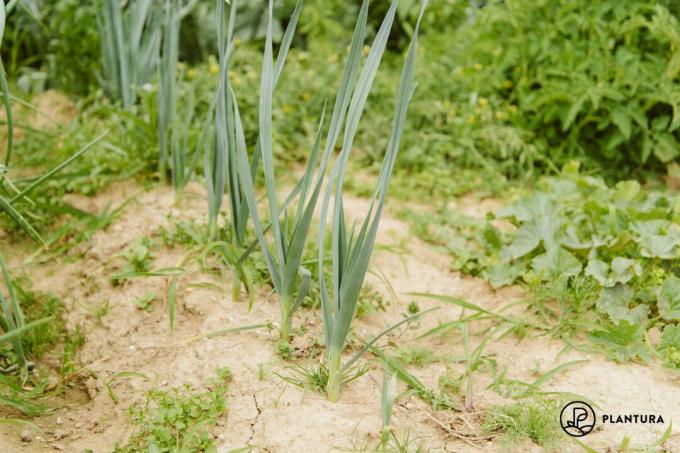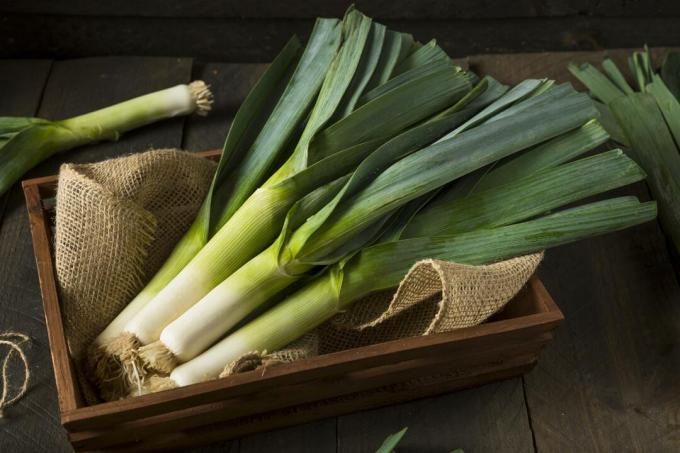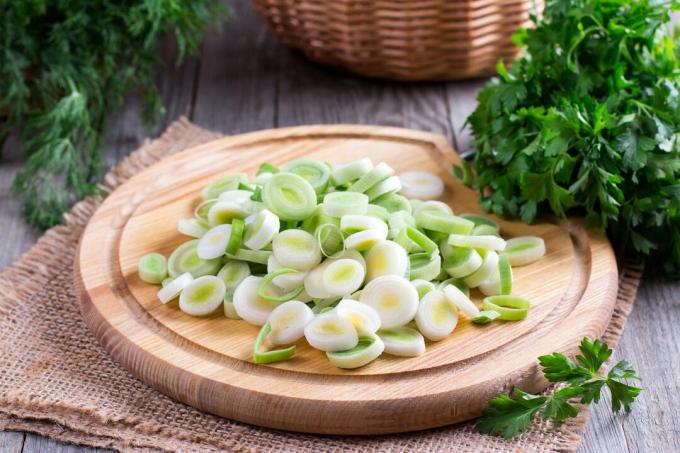Leek is healthy, popular and thrives in your own garden: We show everything about its origins and origins and give tips on growing, harvesting and storing.

Leek (Allium porrum) has been valued as a vegetable since ancient times. Egyptian wall paintings show that it was already very popular at that time. The leeks from Egypt came to Europe through the Romans. It is believed that the leek originated from the wild summer leek, which is also found in Egypt and other Mediterranean countries. It is not only from its Latin name that one can conclude that it is related to the onion: smell and taste are clear indicators! While older and traditional varieties are still on the base of the stem (above the roots) develop a slightly onion-shaped thickening, this is no longer found in modern cultivars.
Many types of leeks are hardy. They can also be harvested in the following year by the end of April. After that, it is usually too late because the leeks are already beginning to bloom. A round-oval umbel with many small white to pink flowers then forms on the long flower stem.
Synonyms: leek, red onion, meat leek, garden leek, broad leek, garden leek
contents
-
Growing leeks properly
- Leek comes in numerous varieties
- Things to know about harvesting and storing leeks
- Ingredients and uses in the kitchen
- Diseases and pests in leek cultivation
Growing leeks properly
Leek is one of the strong eaters. It prefers loose and slightly sandy soils. The soil should be rich in nutrients and, ideally, loosened up deeply before planting. Sunny and partially shaded locations are ideal for cultivation. Ordinary garden soil should be supplemented with plenty of compost (up to 10 liters per square meter). This not only improves the supply of nutrients, but also the ability of the soil to store water. In addition to nutrients, leeks always need sufficient moisture.

Depending on the bed planning, you can either prefer leeks or sow them directly in the field. If you want to plant leeks as a previous crop, you should put the seeds on the windowsill for five to six weeks. From mid-April the young plants can then be planted in the bed at a distance of about 15 cm. Sowing the seeds of the early varieties outdoors should be considered from March onwards. Later varieties that you want to harvest in autumn or winter can be sown between May and June. With a size of 15cm the seedlings are pricked out and then transplanted at a distance of 15cm. The planting depth should be about 10-12cm, because you want to increase the white part of the leek shaft.

Some leek lovers who are keen to experiment use the so-called hole planting method. Here, the young plants are allowed to grow longer before transplanting. Then a 20-25cm deep lock is poked into the loosened soil. The seedling is then carefully lowered into the hole so that the upper tips of the leaves are just sticking out of the earth.
During the growth phase it should be fertilized three to four times at intervals of two weeks. A complete fertilizer is ideal here. Regular piling up of soil around the plant creates a long, white stem. The white part of the leek has a very mild taste and a particularly delicate texture.
Detailed step-by-step instructions for the Cultivation of leeks You will find here.
Leek comes in numerous varieties
The leek we know is mostly divided into summer and autumn / winter leeks. The harvest time is not the only decisive factor here: most summer varieties are not sufficiently frost-hardy to withstand sub-zero temperatures.
You can find an extensive overview of varieties here: Leeks: choosing the right variety to grow.
Summer leek
- Bavaria: very early and fast growing summer leeks with long shafts with a high proportion of white; should be driven forward and is suitable as a previous crop.
- Formerly a giant: the variety, also known as the major, is fast-growing, high-yielding and has a particularly long and thick stem. A very high-yielding variety that clearly deserves a cultivation recommendation. Can be driven forward and thus planted as a previous crop.
- elephant: fast-growing variety with thick, short-medium-long stems; not frost hardy and therefore harvestable until November.
- Megaton (F1): very fast growing and long stemmed variety with a high yield.

- Blue-green autumn: this type of leek is also often referred to and sold as Pandora or Ideal. Classic autumn leek with long (up to 30cm) white shafts; very good yield.
- D’Elbeuf: proven and fast-growing autumn leek variety that is traditionally grown in France. The stems are relatively thick, but shorter than those of long-stemmed varieties such as Blue-Green Autumn. Very good aroma and reliable yield; blue-green foliage.
- Furor: French variety that is traditionally grown as autumn leek. If planted correctly, the medium-long shaft is pure white and particularly delicate.
- Hannibal: classic and fast growing autumn variety; medium-long and very thick shafts with a slight bulb shape on the base (above the root system).
- Porbella: French variety harvested in autumn; Porballa is frost-resistant, has long, white shafts; the leaves have a bluish cast.
- tenor: Another autumn variety from France with good stem properties and a slight formation of two bells on the base; high-yielding and aromatic; frost-proof.
Winter leek
- Blue-green winter: this variety is also known as Eskimo or Farinto and produces long and thick shafts; particularly hardy and can be harvested in milder areas from October to March; very good aroma.
- Bleu Solaise: traditional and old winter variety from France, which is particularly robust and frost-resistant. The shaft is medium-long, thick and has a slight onion shape on the base; the foliage has a distinct bluish cast.
- D‘hiver de Saint Victor: autumn and winter variety also known in Germany as Siegfried; the shafts are quite thick, if not particularly long; very good aroma.
- Forrest: particularly hardy leek selection with firm, long and thick stems; good aroma and delicate texture. Is suitable for late transplanting, as it can be harvested until the coming April due to the winter hardiness. If you harvest the following year, you should have harvested all plants before flowering in May.

For all leek lovers it should be just as interesting that the pickled silver onions so popular in Germany were originally obtained from a wild leek species (Allium ampeloprasum). In German, these spring onions are called pearl onions. The silver onions are now made from special vegetable onions (Allium cepa). The pearl onion is no longer of any importance in commercial cultivation. The elephant garlic Elephant Garlic) shares the same fate. Elephant garlic is a type of leek that is closely related to leek and forms large bulbs that are very similar to garlic. However, the bulbs usually only consist of a single toe. In terms of taste, this type of leek is reminiscent of garlic, but has a much milder taste and can be grilled as an accompaniment to meat or antipasti.
Things to know about harvesting and storing leeks
It is best to cut the leek just above the roots. These remain in the soil and serve as organic nutrient mass. This is one of the reasons why the plant is so suitable as a previous crop. Late-ripening winter leek varieties can also be dug up from the end of November to the beginning of December and then felled loosely. So you have fresh leeks from your own garden all winter long. Leek can also be kept in the refrigerator for up to two weeks. The best thing to do is to remove the uppermost parts of the leaf (which are only available in stores anyway) and wrap the shaft in a damp kitchen towel.

Ingredients and uses in the kitchen
The leek has a very high mineral content, especially potassium, calcium and iron. Vitamins A, B1, B2 and C are also contained in these vegetables. In addition, leek is rich in many phytochemicals, such as sulfur-containing compounds, which are said to have an antibacterial effect. Leek is usually steamed, briefly seared or added to soups. The vegetables look particularly good in fish and mussel soups. Also baked with ham and cheese or as quiches, it unfolds its spicy aroma. Unlike most winter vegetables, leeks can also be eaten raw. You can cut the shaft into thin slices and use it to cover bread or make a delicious salad.

Diseases and pests in leek cultivation
The two main pests are the Thrips (Thrips tabaci) and the leek moth (Acrolepiopsis assectella). While the former makes the leaves turn silver-gray, the leek moth eats unsightly holes in the leek.
Infestation with lice and onion flies can also occur from time to time. Covering the plants with a fine-meshed net usually helps against these pests. It is important that this is done in good time.
Fungi can also damage the leek, but fortunately they are rare.
Viral diseases, which can best be prevented by a long crop rotation, are just as rare. Mixed cultures should grow in your own garden anyway, because these significantly reduce the risk of a major virus infestation.
